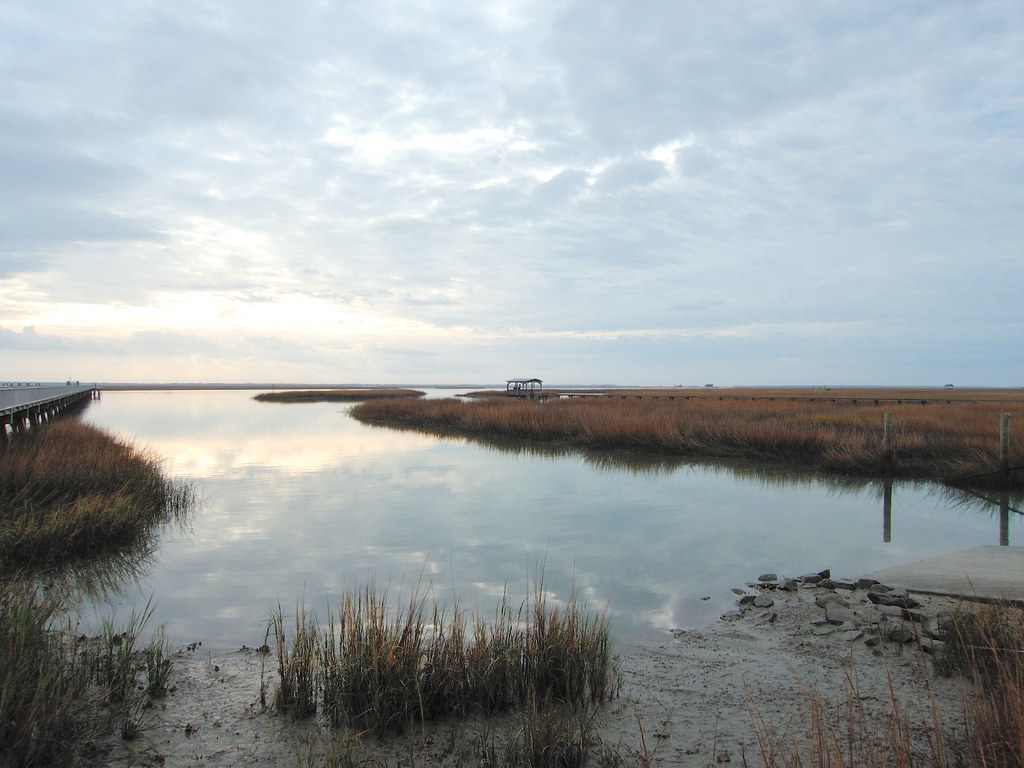Everything You Need to Know About Pluff Mud

Pluff mud is a distinctive and emblematic feature of the coastal Lowcountry in the United States, particularly in our hometown of Charleston, South Carolina.
This thick, dark, and gooey mud is formed primarily from decaying plant material, such as marsh grasses and oyster shells, that has broken down over time. Its unique composition and appearance make it a fascinating aspect of the local landscape, shaping the area’s ecology and culture.
Charleston’s unique tidal marshes, estuaries, and expansive coastline provide the ideal environment for pluff mud to form and thrive. These natural features not only contribute to the formation of pluff mud but also create a diverse and dynamic ecosystem that supports various plant and animal species.
The abundance of pluff mud in the region reflects the richness of Charleston’s environment, and its presence is a testament to the area’s ecological and cultural significance.
Origin of the term “Pluff”
The term “pluff” is derived from the local Gullah dialect, which refers to the soft, mucky texture of this muddy substance. Gullah is a creole language spoken by the Gullah people, African Americans who live in the Lowcountry region of South Carolina and Georgia. The word “pluff” aptly captures the essence of this unique mud, as it emphasizes its soft, sinking quality.
Ecological Importance
The significance of pluff mud in Charleston cannot be understated, as it plays a vital role in the region’s ecosystem. The nutrient-rich composition of pluff mud provides a nourishing foundation for the diverse flora and fauna found in the area.
Its presence contributes to the overall health and balance of Charleston’s Lowcountry environment, highlighting the importance of preserving and protecting these unique habitats.
Supporting Plant and Animal Life
Rich in nutrients, pluff mud supports an array of plant and animal life that make their home in the marshes and waterways. These habitats are critical for species such as oysters, shrimp, crabs, and various types of fish.
The marsh grasses that grow in the pluff mud also provide essential nesting and feeding grounds for numerous bird species. This abundance of life makes the Charleston region a hotspot for biodiversity and a vital part of the larger coastal ecosystem.
Protection from Erosion and Storm Surges
Additionally, the marsh grasses that grow in the pluff mud act as a natural buffer, protecting the coastline from erosion and storm surges. Their extensive root systems help to stabilize the shoreline and prevent soil loss, while the above-ground vegetation slows down wave action and absorbs excess water.
This interconnected relationship between pluff mud and the environment not only helps to maintain a healthy ecosystem but also preserves the natural beauty and resilience of Charleston’s Lowcountry.
Cultural Significance
Influence on Art, Literature, and Music
Pluff mud holds a special place in the hearts of Charleston residents and has inspired countless works of art, literature, and music. Artists, writers, and musicians from the region have incorporated the unique characteristics of pluff mud into their creations, using it as a symbol of the Lowcountry’s distinct identity.
The mud’s texture, color, and even its distinctive smell have all been used as creative elements, showcasing the deep connection between the people of Charleston and their environment.
Symbol of Regional Heritage
Beyond its artistic influence, pluff mud also serves as a symbol of the region’s unique heritage. For generations, the residents of Charleston have built their lives around the marshes and waterways, developing a strong connection to the land and its natural resources.
The presence of pluff mud in the region is a constant reminder of the Lowcountry’s history and the resilience of the people who have called this place home. It is a testament to their adaptability and the enduring bond between humans and nature.
Impact on Local Culinary Traditions
Pluff mud even plays a part in local culinary traditions, with the flavor of seafood caught in the area often attributed to the rich nutrients found in the mud. The presence of pluff mud in the waterways contributes to the unique taste of Charleston’s seafood, making it a sought-after delicacy for food lovers.
Oysters, shrimp, and crabs harvested from these nutrient-rich waters are considered a culinary staple, and local chefs take pride in incorporating these fresh ingredients into their dishes.
For residents and visitors alike, the taste of pluff mud-infused seafood is a tangible reminder of the region’s rich natural bounty and cultural heritage.